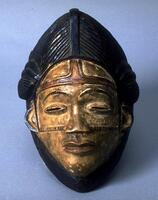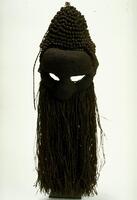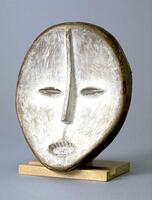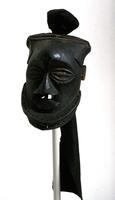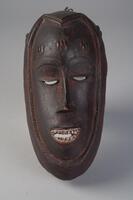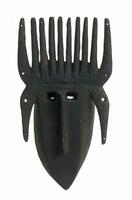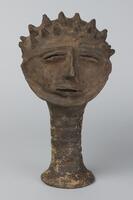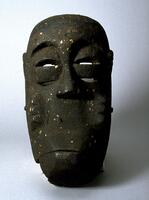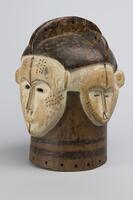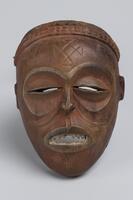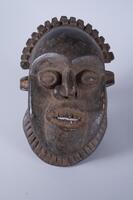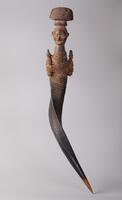20 Items in this Learning Collection
Collection Object
Collection Object
Collection Object
Collection Object
Collection Object
Collection Object
Collection Object
Collection Object
Copyright
All Rights Reserved
()
Mask
Accession Number
2005/1.200
Title
Mask
Artist(s)
Pende
Artist Nationality
Pende
Object Creation Date
circa 1930
Medium & Support
wood, pigments, vegetable fiber, raffia
Dimensions
15 3/8 in x 8 1/4 in x 8 1/4 in (39.05 cm x 20.96 cm x 20.96 cm);15 3/8 in x 8 1/4 in x 8 1/4 in (39.05 cm x 20.96 cm x 20.96 cm)
Credit Line
Gift of Candis and Helmut Stern
Label copy
Mbangu Mask
Central Pende Peoples
Democratic Republic of the Congo
circa 1930
Wood, pigments, vegetable fiber, raffia
Gift of Candis and Helmut Stern, 2005/1.200
The twisted face and dramatic opposition of black and white identify this mask as an Mbangu mask, which represents infirmity and sickness—conditions that are often attributed to witchcraft. According to a common Pende explanation, Mbangu’s half-white, half-black face represents the scars of someone who fell into the fire due to sorcery, while the asymmetry of the face and the marks on the black side are an indication of various other medical conditions. When the mask appears in performance, the dancer limps on a cane to convey the physical weakness of Mbangu, and he wears a humpback pierced with an arrow in reference to sorcerers who shoot their victims with invisible arrows.
Mbangu masks have a long history among Central Pende peoples. While examples from the first decade of the twentieth century do not have pierced eyes and were worn on the forehead, after that the Mbangu genre became a facemask, with pierced eyes and distortion of the facial features. Throughout the twentieth century, from the era of Belgian colonial rule (1885–1960) into the period after independence, Pende performers also invented new forms and genres of masks, whose popularity has waxed and waned over time. Today, the importance of masquerade remains strong, although the Pende have largely removed masquerading from its original ritual context and instead stress the power of masks to “beautify” the village and bring happiness to its inhabitants.
(6/29/10)
Subject matter
This striking half-white, half-black mask featuring a contorted face is attributed to the Pende, who today live in the Democratic Republic of the Congo. Known as mbangu, Pende dancers wear black-and-white masks with twisted visages in ceremonial performances to depict the ill, infirm, and disfigured. The exact origin of the mbangu is unclear; however, one oft-told story describes an epileptic who fell into a fire causing half of his face to be burned. Other accounts detail someone who suffered from facial paralysis as a result of a diviner’s spell.
The visual dualism of the contrasting pigment symbolizes Pende beliefs regarding the opposing forces of good and evil, sickness and health. White represents the spirits of the deceased and the hope of recovery from a malady; black, on the other hand, connotes the brutality of illness.
In order to emphasize the character’s infirmity during a dance, a performer limped on a cane and either wore a hump on his back pierced by an arrow or carried bows and and arrows upon his belt, a reference to metaphorically shooting one’s prey by casting an evil spell. Ultimately, the mbangu visually illustrates for audience members the belief that affliction is often the result of malice from others and can strike anyone at any moment; therefore, one should not ridicule those stricken but extend support and compassion.
References:
African Form and Imagery: Detroit Collects. Ed. Judith A. Ruskin. Detroit: Detroit Institute of Arts Founders Society, 1996.
Maurer, Evan M. and Niangi Batulukisi. Spirits Embodied: Art of the Congo, Selections from the Helmut F. Stern Collection. Minneapolis: The Minneapolis Institute of Arts, 1999.
Physical Description
This bold and dramatic wooden Pende mbangu mask features a half-white, half-black face with a contorted visage. The face has been carved in such a way that the features appearing on the left side, which has been pigmented black, are either positioned lower (the left ear and eye) or droop downwards (left sides of the nose and mouth). Moreover, the black portion of the face features several indentations representing scars. The resulting visual effect is one of facial asymmetry. A thick layer of white and black pigment has been applied to the face’s wooden surface, while black raffia fibers have been tightly woven onto a vegetable fiber cloth on the black half of the mask, completing the look.
Primary Object Classification
Sculpture
Primary Object Type
mask
Collection Area
African
Rights
If you are interested in using an image for a publication, please visit http://umma.umich.edu/request-image for more information and to fill out the online Image Rights and Reproductions Request Form. Keywords
asymmetry (composition concept)
black pigment
disease
face masks
illness
white pigment
2005/1.200
Title
Mask
Artist(s)
Pende
Artist Nationality
Pende
Object Creation Date
circa 1930
Medium & Support
wood, pigments, vegetable fiber, raffia
Dimensions
15 3/8 in x 8 1/4 in x 8 1/4 in (39.05 cm x 20.96 cm x 20.96 cm);15 3/8 in x 8 1/4 in x 8 1/4 in (39.05 cm x 20.96 cm x 20.96 cm)
Credit Line
Gift of Candis and Helmut Stern
Label copy
Mbangu Mask
Central Pende Peoples
Democratic Republic of the Congo
circa 1930
Wood, pigments, vegetable fiber, raffia
Gift of Candis and Helmut Stern, 2005/1.200
The twisted face and dramatic opposition of black and white identify this mask as an Mbangu mask, which represents infirmity and sickness—conditions that are often attributed to witchcraft. According to a common Pende explanation, Mbangu’s half-white, half-black face represents the scars of someone who fell into the fire due to sorcery, while the asymmetry of the face and the marks on the black side are an indication of various other medical conditions. When the mask appears in performance, the dancer limps on a cane to convey the physical weakness of Mbangu, and he wears a humpback pierced with an arrow in reference to sorcerers who shoot their victims with invisible arrows.
Mbangu masks have a long history among Central Pende peoples. While examples from the first decade of the twentieth century do not have pierced eyes and were worn on the forehead, after that the Mbangu genre became a facemask, with pierced eyes and distortion of the facial features. Throughout the twentieth century, from the era of Belgian colonial rule (1885–1960) into the period after independence, Pende performers also invented new forms and genres of masks, whose popularity has waxed and waned over time. Today, the importance of masquerade remains strong, although the Pende have largely removed masquerading from its original ritual context and instead stress the power of masks to “beautify” the village and bring happiness to its inhabitants.
(6/29/10)
Subject matter
This striking half-white, half-black mask featuring a contorted face is attributed to the Pende, who today live in the Democratic Republic of the Congo. Known as mbangu, Pende dancers wear black-and-white masks with twisted visages in ceremonial performances to depict the ill, infirm, and disfigured. The exact origin of the mbangu is unclear; however, one oft-told story describes an epileptic who fell into a fire causing half of his face to be burned. Other accounts detail someone who suffered from facial paralysis as a result of a diviner’s spell.
The visual dualism of the contrasting pigment symbolizes Pende beliefs regarding the opposing forces of good and evil, sickness and health. White represents the spirits of the deceased and the hope of recovery from a malady; black, on the other hand, connotes the brutality of illness.
In order to emphasize the character’s infirmity during a dance, a performer limped on a cane and either wore a hump on his back pierced by an arrow or carried bows and and arrows upon his belt, a reference to metaphorically shooting one’s prey by casting an evil spell. Ultimately, the mbangu visually illustrates for audience members the belief that affliction is often the result of malice from others and can strike anyone at any moment; therefore, one should not ridicule those stricken but extend support and compassion.
References:
African Form and Imagery: Detroit Collects. Ed. Judith A. Ruskin. Detroit: Detroit Institute of Arts Founders Society, 1996.
Maurer, Evan M. and Niangi Batulukisi. Spirits Embodied: Art of the Congo, Selections from the Helmut F. Stern Collection. Minneapolis: The Minneapolis Institute of Arts, 1999.
Physical Description
This bold and dramatic wooden Pende mbangu mask features a half-white, half-black face with a contorted visage. The face has been carved in such a way that the features appearing on the left side, which has been pigmented black, are either positioned lower (the left ear and eye) or droop downwards (left sides of the nose and mouth). Moreover, the black portion of the face features several indentations representing scars. The resulting visual effect is one of facial asymmetry. A thick layer of white and black pigment has been applied to the face’s wooden surface, while black raffia fibers have been tightly woven onto a vegetable fiber cloth on the black half of the mask, completing the look.
Primary Object Classification
Sculpture
Primary Object Type
mask
Collection Area
African
Rights
If you are interested in using an image for a publication, please visit http://umma.umich.edu/request-image for more information and to fill out the online Image Rights and Reproductions Request Form. Keywords
asymmetry (composition concept)
black pigment
disease
face masks
illness
white pigment
